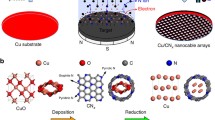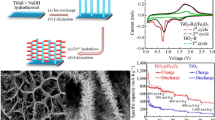Abstract
The careful design of nano-architectures and smart hybridization of expected active materials can lead to more advanced properties. Here we have engineered a novel hierarchical branching Cu/Cu2O/CuO heteronanostructure by combining a facile hydrothermal method and subsequent controlled oxidation process. The fine structure and epitaxial relationship between the branches and backbone are investigated by high-resolution transmission electron microscopy. Moreover, the evolution of the branch growth has also been observed during the gradual oxidation of the Cu nanowire surface. The experimental results suggest that the surface oxidation needs to be performed via a two-step exposure process to varying humidity in order to achieve optimized formation of a core-shell structured branching architecture. Finally, a proof-of-concept of the function of such a hierarchical framework as the anode material in lithium-ion batteries is demonstrated. The branching core-shell heterostructure improves battery performance by several means: (i) The epitaxially grown branches provide a high surface area for enhanced electrolyte accessibility and high resistance to volume change induced by Li+ intercalation/extraction; (ii) the core-shell structure with its well-defined heterojunction increases the contact area which facilitates effective charge transport during lithiation; (iii) the copper core acts as a current collector as well as providing structural reinforcement.

Similar content being viewed by others
Change history
15 September 2017
The authors note that there is an extra incorrect citation for Fig. S5 appeared on page 2770. It has also come to our attention that Figs. 5 and 6 appeared incorrectly. The correct figures and their legend appear below. These errors don’t affect the conclusions of the article.
References
Bierman, M. J.; Jin, S. Potential applications of hierarchical branching nanowires in solar energy conversion. Energy Environ. Sci. 2009, 2, 1050–1059.
Lee, C. W.; Seo, S. D.; Kim, D. W.; Park, S.; Jin, K.; Kim, D. W.; Hong, K. S. Heteroepitaxial growth of ZnO nanosheet bands on ZnCo2O4 submicron rods toward high-performance Li ion battery electrodes. Nano Res. 2013, 6, 348–355.
Wu, H.; Xu, M.; Wang, Y. C.; Zheng, G. F. Branched Co3O4/Fe2O3 nanowires as high capacity lithium-ion battery anodes. Nano Res. 2013, 6, 167–173.
Jiang, X. C.; Tian, B. Z.; Xiang, J.; Qian, F.; Zheng, G. F.; Wang, H. T.; Mai, L. Q.; Lieber, C. M. Rational growth of branched nanowire heterostructures with synthetically encoded properties and function. Proc. Natl. Acad. Sci. USA 2011, 108, 12212–12216.
Liu, C.; Tang, J. Y.; Chen, H. M.; Liu, B.; Yang, P. D. A fully integrated nanosystem of semiconductor nanowires for direct solar water splitting. Nano Lett. 2013, 13, 2989–2992.
Cheng, C. W.; Fan, H. J. Branched nanowires: Synthesis and energy applications. Nano Today 2012, 7, 327–343.
Zhou, S.; Liu, X. H.; Wang, D. W. Si/TiSi2 heteronanostructures as high-capacity anode material for Li ion batteries. Nano Lett. 2010, 10, 860–863.
Zhou, S.; Yang, X. G.; Xie, J.; Simpson, Z. I.; Wang, D. W. Titanium silicide nanonet as a new material platform for advanced lithium ion battery applications. Chem. Commun. 2013, 49, 6470–6476.
Ke, F. S.; Huang, L.; Solomon, B. C.; Wei, G. Z.; Xue, L. J.; Zhang, B.; Li, J. T.; Zhou, X. D.; Sun, S. G. Three-dimensional nanoarchitecture of Sn-Sb-Co alloy as an anode of lithium-ion batteries with excellent lithium storage performance. J. Mater. Chem. 2012, 22, 17511–17517.
Zhou, W. W.; Cheng, C. W.; Liu, J. P.; Tay, Y. Y.; Jiang, J.; Jia, X. T.; Zhang, J. X.; Gong, H.; Hng, H. H.; Yu, T. et al. Epitaxial growth of branched α-Fe2O3/SnO2 nano-heterostructures with improved lithium-ion battery performance. Adv. Funct. Mater. 2011, 21, 2439–2445.
Liu, J. P.; Jiang, J.; Cheng, C. W.; Li, H. X.; Zhang, J. X.; Gong, H.; Fan, H. J. Co3O4 nanowire@MnO2 ultrathin nanosheet core/shell arrays: A new class of high-performance pseudocapacitive materials. Adv. Mater. 2011, 23, 2076–2081.
Zhou, S.; Yang, X. G.; Lin, Y. J.; Xie, J.; Wang, D. W. A nanonet-enabled Li ion battery cathode material with high power rate, high capacity, and long cycle lifetime. ACS Nano 2012, 6, 919–924.
Feng, Y. Z.; Cho, I. S.; Rao, P. M.; Cai, L. L.; Zheng, X. L. Sol-flame synthesis: A general strategy to decorate nanowires with metal oxide/noble metal nanoparticles. Nano Lett. 2013, 13, 855–860.
Xia, X. H.; Tu, J. P.; Zhang, Y. Q.; Chen, J.; Wang, X. L.; Gu, C. D.; Guan, C.; Luo, J. S.; Fan, H. J. Porous hydroxide nanosheets on preformed nanowires by electrodeposition: Branched nanoarrays for electrochemical energy storage. Chem. Mater. 2012, 24, 3793–3799.
Biesinger, M. C.; Lau, L. W. M.; Gerson, A. R.; Smart, R. St. C. Resolving surface chemical states in XPS analysis of first row transition metals, oxides and hydroxides: Sc, Ti, V, Cu and Zn. Appl. Surf. Sci. 2010, 257, 887–898.
Epitaxial Growth; J. W. Matthews, Ed.; Academic Press: New York, 1975.
Zhang, Q. B.; Wang, J. X.; Xu, D. G.; Wang, Z. X.; Li, X. H.; Zhang, K. L. Facile large-scale synthesis of vertically aligned CuO nanowires on nickel foam: Growth mechanism and remarkable electrochemical performance. J. Mater. Chem. A 2014, 2, 3865–3874.
Sun, S. D.; Yang, Z. M. Recent advances in tuning crystal facets of polyhedral cuprous oxide architectures. RSC Adv. 2014, 4, 3804–3822.
Wang, J.; Liu, Y. C.; Wang, S. Y.; Guo, X. T.; Liu, Y. P. Facile fabrication of pompon-like hierarchical CuO hollow microspheres for high-performance lithium-ion batteries. J. Mater. Chem. A 2014, 2, 1224–1229.
Zhu, C. R.; Chao, D. L.; Sun, J.; Bacho, I. M.; Fan, Z. X.; Ng, C. F.; Xia, X. H.; Huang, H.; Zhang, H.; Shen, Z. X. et al. Enhanced lithium storage performance of CuO nanowires by coating of graphene quantum dots. Adv. Mater. Interfaces, in press, DOI: 10.1002/admi.201400499.
Hirsch, P. B. Electron Microscopy of Thin Crystals; Krieger Pub. Co: New York, 1977.
Niu, M. T.; Huang, F.; Cui, L. F.; Huang, P.; Yu, Y. L.; Wang, Y. S. Hydrothermal synthesis, structural characteristics, and enhanced photocatalysis of SnO2/α-Fe2O3 semiconductor nanoheterostructures. ACS Nano 2010, 4, 681–688.
Casavola, M.; Grillo, V.; Carlino, E.; Giannini, C.; Gozzo, F.; Fernandez Pinel, E.; Garcia, M. A.; Manna, L.; Cingolani, R.; Cozzoli, P. D. Topologically controlled growth of magnetic-metal-functionalized semiconductor oxide nanorods. Nano Lett. 2007, 7, 1386–1395.
Nakamura, R.; Matsubayashi, G.; Tsuchiya, H.; Fujimoto, S.; Nakajima, H. Formation of oxide nanotubes via oxidation of Fe, Cu and Ni nanowires and their structural stability: Difference in formation and shrinkage behavior of interior pores. Acta Mater. 2009, 57, 5046–5052.
Soon, A.; Todorova, M.; Delley, B.; Stampfl, C. Oxygen adsorption and stability of surface oxides on Cu (111): A first-principles investigation. Phys. Rev. B 2006, 73, 165424.
Poizot, P.; Laruelle, S.; Grugeon, S.; Dupont, L.; Tarascon, J. M. Nano-sized transition-metal oxides as negative-electrode materials for lithium-ion batteries. Nature 2000, 407, 496–499.
Wu, H.; Zheng, G. Y.; Liu, N.; Carney, T. J.; Yang, Y.; Cui, Y. Engineering empty space between Si nanoparticles for lithium-ion battery anodes. Nano Lett. 2012, 12, 904–909.
Lou, X. W.; Deng, D.; Lee, J. Y.; Feng, J.; Archer, L. A. Self-supported formation of needlelike Co3O4 nanotubes and their application as lithium-ion battery electrodes. Adv. Mater. 2008, 20, 258–262.
Débart, A.; Dupont, L.; Poizot, P.; Leriche, J. B.; Tarascon, J. M. A transmission electron microscopy study of the reactivity mechanism of tailor-made CuO particles toward lithium. J. Electrochem. Soc. 2001, 148, A1266-A1274.
Ko, S.; Lee, J. I.; Yang, H. S.; Park, S.; Jeong, U. Mesoporous CuO particles threaded with CNTs for high-performance lithium-ion battery anodes. Adv. Mater. 2012, 24, 4451–4456.
Sahay, R.; Suresh Kumar, P.; Aravindan, V.; Sundaramurthy, J.; Ling, W. C.; Mhaisalkar, S. G.; Ramakrishna, S.; Madhavi, S. High aspect ratio electrospun CuO nanofibers as anode material for lithium-ion batteries with superior cycleability. J. Phys. Chem. C 2012, 116, 18087–18092.
Li, X. F.; Dhanabalan, A.; Bechtold, K.; Wang, C. L. Binder-free porous core-shell structured Ni/NiO configuration for application of high performance lithium ion batteries. Electrochem. Commun. 2010, 12, 1222–1225.
Gao, X. P.; Bao, J. L.; Pan, G. L.; Zhu, H. Y.; Huang, P. X.; Wu, F.; Song, D. Y. Preparation and electrochemical performance of polycrystalline and single crystalline CuO nanorods as anode materials for Li ion battery. J. Phys. Chem. B 2004, 108, 5547–5551.
Wang, X.; Tang, D. M.; Li, H. Q.; Yi, W.; Zhai, T. Y.; Bando, Y.; Golberg, D. Revealing the conversion mechanism of CuO nanowires during lithiation-delithiation by in situ transmission electron microscopy. Chem. Commun. 2012, 48, 4812–4814.
Qu, J.; Li, H. Q.; Henry, J. J.; Martha, S. K.; Dudney, N. J.; Xu, H. B.; Chi, M. F.; Lance, M. J.; Mahurin, S. M.; Besmann, T. M. et al. Self-aligned Cu-Si core-shell nanowire array as a high-performance anode for li-ion batteries. J. Power Sources 2012, 198, 312–317.
Cao, F. F.; Deng, J. W.; Xin, S.; Ji, H. X.; Schmidt, O. G.; Wan, L. J.; Guo, Y. G. Cu-Si nanocable arrays as high-rate anode materials for lithium-ion batteries. Adv. Mater. 2011, 23, 4415–4420.
Author information
Authors and Affiliations
Corresponding authors
Additional information
These authors contributed equally to this work.
An erratum to this article is available at https://doi.org/10.1007/s12274-017-1843-5.
Electronic supplementary material
Rights and permissions
About this article
Cite this article
Zhao, Y., Zhang, Y., Zhao, H. et al. Epitaxial growth of hyperbranched Cu/Cu2O/CuO core-shell nanowire heterostructures for lithium-ion batteries. Nano Res. 8, 2763–2776 (2015). https://doi.org/10.1007/s12274-015-0783-1
Received:
Revised:
Accepted:
Published:
Issue Date:
DOI: https://doi.org/10.1007/s12274-015-0783-1




